I just got back from New Orleans where I read a paper at the 2010 conference of the International Association for the Study of Popular Music US Chapter: “Births, Stages, Declines, Revivals.” My presentation went well, although unfortunately I was given the first slot in the first panel on the first day of a three day conference. (8:30 AM on Friday morning!) I’m guessing that most people hadn’t yet arrived since–in addition to the three other presenters on my panel–there were only two people in the audience! Oh well.
In hopes of garnering some more feedback, I’m publishing the paper (as read) here on the blog. As usual, this remains a work in progress.
Click here to download a PDF version of the paper. (Slides and visual examples appear at the end of the PDF.) Or, follow the jump to read the html version.
Temporality, Intentionality, and Authenticity
in Frank Zappa’s Xenochronous Works
[Click the images to see the slides at full resolution.]
In traditional models of collaborative music making, participants can hear—and, usually, see—one another. Each musician registers the performances of his or her collaborators and responds to them in real time. Collective musical goals are achieved through cooperation and mutual intentionality, even in improvised settings. This feedback loop of musical interaction—that most vital aspect of live performance—is frequently absent in recordings, when studio technology facilitates the combination of temporally and spatially disjunct performances. Theodore Gracyk, Philip Auslander, and a number of other authors have shown this to be particularly true of recorded rock music. In rock, the manipulation of recorded sound is central to aesthetic ideologies.
Lee B. Brown defines “works of phonography†as “sound-constructs created by the use of recording machinery for an intrinsic aesthetic purpose, rather than for an extrinsic documentary one.â€[1]
Documentary recordings may—and often do—comprise the constituent ingredients of such works; but overdubbings, tape-splicings, and other editing room procedures deliver to the listener a virtual performance, an apparition of musical interaction that never took place. Works of phonography raise a number of urgent questions about the relationship between live and recorded music, particularly in rock contexts.
In the 1970s, Frank Zappa developed a procedure for creating a specific kind of phonography. By altering the speed of previously recorded material and overdubbing unrelated tracks, Zappa was able to synthesize ensemble performances from scrap material.
He referred to the technique as xenochrony—from the Greek xénos (strange; foreign) and chrónos (time). Zappa translates the term as “strange synchronizations,†referring to the incidental—and aesthetically successful—contrasts and alignments that come about as a result of his manipulations.
Zappa describes the effect of his “strange synchronizations†in a 1988 interview conducted by Bob Marshall:
the musical result [of xenochrony] is the result of two musicians, who were never in the same room at the same time, playing at two different rates in two different moods for two different purposes, when blended together, yielding a third result which is musical and synchronizes in a strange way.[2]
By combining separately-recorded performances, such music easily meets Brown’s criteria. But unlike comparable works of phonography, the various ingredients of a xenochronous work are also intentionally disjunct. Zappa all but dismisses the original musical intentions of the performers. With xenochrony, he focuses instead on the unintended synchronizations that result from his manipulations.
In many cases, rock artists and producers mask their methods. Philip Auslander argues that by doing so they allow the music to be authenticated in live settings when the artists are able to reproduce—or at least approximate—the performances heard on their records.[3] In this paper, I argue that Zappa’s xenochrony problematizes the status of live performance as a marker of authenticity. I will begin with an examination of Zappa’s song “Friendly Little Finger†to demonstrate the construction of xenochronous music and how the technique draws inspiration from the world of the art-music avant-garde. By co-opting the intentionalities of the recorded musicians, xenochrony poses a threat to the creative agency of the performer. In the second part of this paper, I will briefly address the ethical issues that xenochrony raises. Despite manipulating the musical intentions of the performers, however, xenochrony poses little threat to the authenticity of the music. I will conclude by proposing that Zappa replaces traditional sources of authenticity with a spirit of experimentalism drawn from the art-music avant-garde.
I. Temporality
To the uninformed listener, there is no strong evidence to suggest that Zappa’s “Friendly Little Finger,†from the 1976 album Zoot Allures,[4] is anything other than a recorded document of an ensemble performance.
The piece begins with a brief introduction featuring a repeated riff performed on guitar, marimba, and synthesizer. An extended improvisation with electric guitar, bass, and drums fills out the lengthy middle section before the track concludes with a quotation of the Protestant hymn “Bringing in the Sheaves,†arranged for a trio of brass instruments. Despite its apparent normalcy, however, “Friendly Little Finger†combines materials from four distinct sources spanning three years of Zappa’s career.
The primary recording—a guitar solo with a droning bass accompaniment—was recorded in the dressing room of the Hofstra University Playhouse as a warm-up before a performance on October 26, 1975. Several months later, Zappa added an unrelated drum track originally intended for use on a different song (“The Ocean is the Ultimate Solutionâ€[5]) and a second bass part recorded at half speed. These three recordings, all appearing in the middle solo section, comprise the xenochronous core of the piece. To this, Zappa superimposed two additional recordings. The introduction comes from the same session as the added bass part, and the coda was recorded several years earlier, during a session for the song “Wonderful Wino.”
As Example 1 makes clear, the result of Zappa’s editing is a moderately dense network of temporally disjunct recordings. How is it that such seemingly disparate recordings happened to come together in this way? What inspired Zappa to take such an approach to manipulating recorded sound? Of course, examples of overdubbing in American popular music can be found at least as far back as the 1940s—recall Sidney Bechet’s One Man Band recordings in which each instrument was performed separately by Bechet himself. But while such tricks had become old hat by the mid 1970s, xenochrony stands out for it also has obvious ties to the twentieth-century art-music avant-garde.
Despite his continuing reputation as a popular musician, Zappa was remarkably well read in the theoretical discourse surrounding avant-garde art music, particularly with regards to musique concrète and tape music. He expressed an ongoing interest in John Cage’s chance operations, for example, trying them out for himself by physically cutting recorded tapes and rearranging the pieces at random for the 1968 album Lumpy Gravy.[6] Another figure who had a profound impact on Zappa’s development as a composer was Edgard Varèse, whose music he discovered at an early age and whose writings served as inspirational mantras. Given this fascination with the avant-garde, xenochrony may be best understood as a conscious attempt by Zappa to model himself on these influential figures. His own approach to music and composition would therefore require an analogous theoretical foundation.
Xenochrony is closely tied to Zappa’s conception of temporality. Zappa often described time as a simultaneity, with all events occurring at once instead of chronologically. Toward the end of his life, in an oft-quoted conversation with cartoonist Matt Groening, Zappa explained that the idea was rooted in physics:
I think of time as a spherical constant, which means that everything is happening all the time. […] They [human beings] take a linear approach to it, slice it in segments, and then hop from segment to segment to segment until they die, and to me that is a pretty inefficient way of preparing a mechanical ground base for physics. That’s one of the reasons why I think physics doesn’t work. When you have contradictory things in physics, one of the reasons they became contradictory is because the formulas are tied to a concept of time that isn’t the proper model.[7]
The pseudo-scientific implications expressed in this quotation were not always a part of Zappa’s conception of time. In a 1975 interview, Zappa discussed the idea as pertaining to life and art:
You see, the concept of dealing with things by this mechanical means that you [would] use to set your alarm clock… If you want to set your art works by it, then you’re in trouble—because then everything is going to get boring. So I’m working on a different type of a time scale.[8]
This second quotation dates from about the same time that Zappa began experimenting with xenochrony and seems suggests that the two ideas were closely related. Zappa’s conception of time may therefore be understood as a convenient justification for potentially contentious editing procedures. Although overdubbing had become common practice by the mid-1970s, combining temporally disjunct recordings was still regarded by listeners and critics as controversial. By reconfiguring the very concept of time, Zappa skirts the issue.
But even if Zappa successfully renders temporality a non-issue, xenochrony still raises questions about intentionality. Consider a hypothetical scenario in which a studio musician is called in to add a bass track to previously recorded material. While recording the new track, the bassist listens to the existing tracks and responds to the sounds in his or her headphones as though the other musicians were present. (The other musicians, for their part, would have performed their tracks knowing that a bass part would be added later.) Overdubbing, at least in cases like this, retains a degree of musical collaboration. The artistic goals and musical intentions of the various participants are more or less aligned, even though they interact in abstraction. Xenochrony, however, dispenses with intentionality altogether. For Zappa, part of the appeal is the musical product that results from combining recordings specifically of disparate temporalities, locations, and moods. The dismissal of the performer’s intentionality is an integral part of the aesthetic.
II. Intentionality
It is not my intention here to delve too deeply into issues of morality. Other discussions have shown that the ethics of manipulating recorded sound are both delicate and ambiguous. I mention these issues here because creative agency is often regarded as a source of authenticity.
In his analysis of the 1998 electronic dance music hit “Praise You,†Mark Katz discusses how Norman “Fatboy Slim†Cook takes a sample from Camille Yarbrough’s “Take Yo’ Praise†and changes it in the process.[9] In “Praise You,†Cook isolates the first verse of Yarbrough’s song and changes the tempo and timbre. Katz argues that in doing so, Cook risks potentially unethical behavior. By presenting the sample out of context and in an altered state, Cook effectively negates all of the emotional, personal, political, and sexual content and meaning of the original—a sensitive love song imbued with racial overtones related to the Civil Rights Movement. Cook therefore presents a threat to Yarbrough’s artistic agency. Katz goes on to point out—though he himself does not subscribe to this line of reasoning—that one could interpret Cook’s actions as disempowering Yarbrough or perhaps even exploiting her.
Zappa takes similar risks with xenochrony. Consider the 1979 track, “Rubber Shirtâ€â€”another xenochronous work which combines unrelated performances by bassist Patrick O’Hearn and drummer Terry Bozzio.
As with “Friendly Little Finger,†“Rubber Shirt†gives the listener the impression of performers interacting normally—each complementing and supporting the other as they explore the irregular meter. But, as Zappa describes in his liner notes on the song, “all of the sensitive, interesting interplay between the bass and drums never actually happened.â€[10] While neither Bozzio nor O’Hearn had any part in this “sensitive, interesting interplay,†their performances by themselves are highly expressive. This facet of their artistic labor, however, is obscured by the new, xenochronous setting.
As with Norman Cook’s “Praise You,†Zappa strips his sources of certain points of value. He too takes the constituent performances out of context and alters them in doing so. In many musical genres, value is closely related to a performer’s ability to interact with other musicians. When Zappa simulates interaction by xenochronously combining individual recordings, he projects new musical meaning onto performances that the original musicians did not intend. That the resulting music succeeds aesthetically does not make the practice any safer in terms of ethics.
Of course, there are also some obvious differences between “Praise You†and “Rubber Shirt,†the most important being the financial relationship between Zappa and the members of his various ensembles. O’Hearn and Bozzio were paid employees, hired to perform Zappa’s music. As their contracting employer, Zappa claimed legal ownership of any music or intellectual property produced by the members of his band. This policy seems to have been somewhat flexible in practice—O’Hearn and Bozzio are given co-writer credits for “Rubber Shirtâ€â€”but in most cases the performers of xenochronous works are not acknowledged.
Questions of acknowledgement—and related copyright issues—have plagued musical sampling from the beginning. But again, xenochrony complicates the issue. Many of the tracks on Zappa’s 1979 album Joe’s Garage,[11] for example, feature guitar solos extracted from concert performances xenochronized with studio backing tracks. All of the audible musicians are credited in the liner notes. But what of the musicians that aren’t audible? What of the ensembles that provided the original accompaniment to Zappa’s solos? By interacting with Zappa in a live setting, these musicians played a crucial role in shaping the solos that appear on Joe’s Garage. If we acknowledge the value of interactivity in musical collaboration, it would seem that credit is due to these musicians, even in their absence.
III. Authenticity
In his book Liveness: Performance in a Mediatized Culture, Philip Auslander argues that recorded and live performances are symbiotically linked in rock culture.[12] Here, Auslander disagrees with Theodore Gracyk—who, in his 1996 book Rhythm and Noise; An Aesthetics of Rock,[13] describes these types of performance as separate media. Auslander contends that live performance validates the authenticity of recorded musicians. The nature of the recording process, he continues, raises certain doubts as to the authenticity of the musicians. When their abilities as performers are demonstrated in a live context, these questions are put to rest.[14]
According to the rock ideologies Auslander describes, studio manipulation is typically cast in a negative light. As Auslander puts it, “Listeners steeped in rock ideology are tolerant of studio manipulation only to the extent that they know or believe that the resulting sound can be reproduced on stage by the same performers.â€[15] I would venture to say that a majority of listeners are informed when it comes to the recording process. Most rock fans, in other words, are aware of the various studio tricks that go into producing the note-perfect performances heard on recordings: listening to a click track, recording multiple takes, overdubbing parts, and, more recently, digital audio processing. Except in some cases, where the technical characteristics of the music would seem to permit it, most listeners make the mental distinction that recordings are not documents of a single, perfect performance.
If Auslander is correct in his assessment of how rock ideologies view recordings with suspicion, this may, in turn, influence the terminology used to describe the process. Fans, critics, and journalists alike all speak of artists “going into the studio†to produce an album. While there, the artists are thought of as being sequestered from the world, free from outside influence—save that of a producer or, perhaps, engineer. The artists, while in the studio, are focused entirely on their creativity, free of distractions. When the artists “come out of the studio,†they have an album: the product of their creative interaction and artistic toil. Such discourse paints the studio process as having a certain purity.
Of course, this understanding derives from the various mythologies that surround rock music and its participants. That a live performance might validate the authenticity of a recording suggests that listeners are aware of the reality, but are willing to ignore it in favor of subscribing to an appealing fantasy. In Zappa’s case, however, these processes are intentionally integrated. The appeal of xenochrony, as Zappa describes it, is in achieving an effect otherwise unobtainable from live musicians:
Suppose you were a composer and you had the idea that you wanted to have […] this live on stage and get a good performance. You won’t get it. You can’t. You can ask for it, but it won’t happen. There’s only one way to hear that, and that’s to do what I did. I put two pieces of tape together.[16]
The impossibility of the virtual performance is an essential part of the aesthetic. Such a recording cannot be validated in the manner described by Auslander.
Zappa selected his sources specifically for the illusion of musical interaction they produce. Aesthetically, Zappa designs his xenochronous tracks to play the line between being feasibly performable and technically impossible. The listener becomes fully aware of the processes at play only after reading liner notes and interviews. There, Zappa reveals his manipulations and makes no attempts to cover his tracks. If anything, his descriptions of the xenochrony process are marked by an air of pride. Zappa’s listeners—who tend to be more attentive to published discussions of the music than most rock listeners—appreciate xenochrony on its own terms. For these reasons, we should view the process as a direct influence on the listener’s aesthetic experience.
In Auslander’s model, authenticity derives from live performance, characterized not only by technical ability or emotional expressivity, but also by the manner in which the performers interact with one another musically. Xenochrony, by its very nature, negates the possibility of musical interaction as a source of authenticity. Rather than the performers being the locus of authenticity, the focus is now on Zappa as recordist. Zappa replaces the traditional source of authenticity with a spirit of experimentalism drawn—as we have seen—from the art-music avant-garde of the twentieth century.
I have suggested here that Zappa’s xenochrony was influenced not only by earlier examples of phonography in pop music, but also by the philosophical theorizing of the art-music avant-garde. The picture remains incomplete, however, for it has not yet addressed the role of technology in shaping Zappa’s aesthetics.
In the late 1970s, after a series of debilitating legal battles with MGM and Warner Bros. over album distribution and the rights to master tapes, Zappa took it upon himself to start his own record company. Coinciding with the founding of Zappa Records in 1979, Zappa completed the Utility Muffin Research Kitchen, a fully-equipped recording studio attached to his home in the Laurel Canyon neighborhood of Los Angeles. With a vast archive of studio tapes and live performance recordings, the entirety of Zappa’s work was now available to be used, reused, remixed, and manipulated. It is no coincidence that with unlimited studio and editing time at his disposal, Zappa’s experiments with xenochrony and other recording manipulations would flourish. Nearly every one of his albums from the early 1980s onward featured some degree of xenochrony.
Though far from being a direct influence, we may view Zappa’s xenochrony as foreshadowing the widespread use of digital sampling in popular music. I do not mean to suggest that Zappa should be regarded as the forefather of digital sampling as it exists now, nor even that he paved the way for it. But I do see a provocative parallel. Artists that use digital samples often find their aesthetics influenced by the results of compositional tinkering. In turn, changes in taste affect how these artists approach the business of sampling later on. I see a similar relationship between Zappa and xenochrony. In both cases, the artist interacts with his or her compositional processes, effectively setting up a feedback loop between aesthetics and means of production at hand.
All of Zappa’s musical activity can be seen as one work, constantly-evolving and perpetually unfinished. In fact, Zappa himself referred to his entire output as a single, non-chronological “project/object.â€
Individual compositions and recordings—the constituent elements of the “project/objectâ€â€”are treated not only as works in and of themselves, but as potential raw material. Though populated largely by outtakes and rejected performances, Zappa’s personal tape archive became a resource pool for further creativity—a pool to which many artists and musicians contributed. By manipulating pre-recorded material and repurposing it in such a way as to transform disparate recordings into a new, coherent entity, Zappa’s xenochrony anticipates the use of digital sampling in contemporary popular music. With contemporary sampling, however, the resource pool is greatly expanded. Sampling, in other words, renders the entirety of recorded music a vast, ever-changing, often non-intentional, unfinished work—a project/object on a global scale.
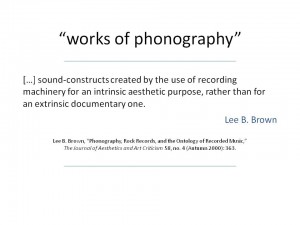

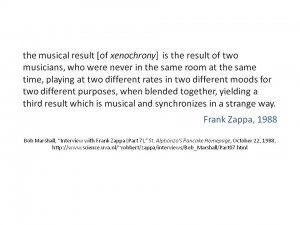
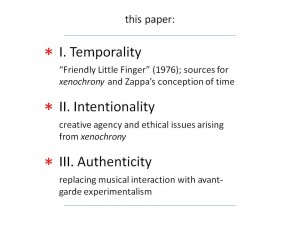
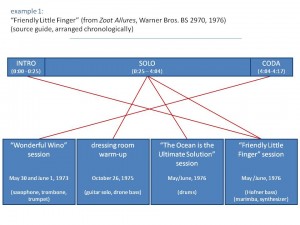
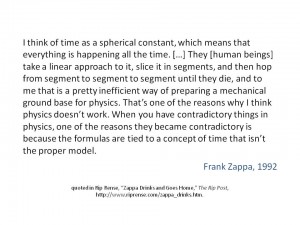
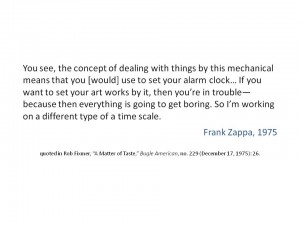
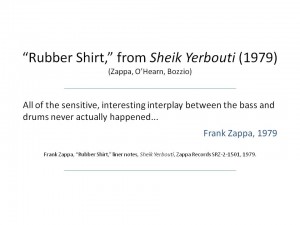
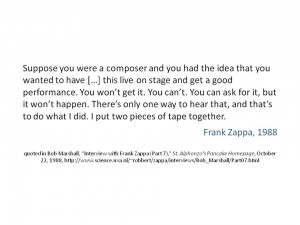

ozdobne damskie szaliki i chusty zara
chusta damska w krat臋 dodatki dla kobiet txmbuty robocze urgent cenaspinki m臋skie do mankiet贸w srebrowype艂niony wz贸r formularza p艂atno艣膰
keen gypsum ii mid waterproof boots
supreme design motorcycle biker leather jacket black 100 leather very exclusivemoncler x thom browne mesh jacketus wings bomber jacketsmoncler x white mountaineering aw 2014 collection crisp culture
sexy brazil cut bikini beachwear
å¸æ¢°è–ªè¤‹æ³»æ‡ˆæ¢° 泻芯屑斜懈薪懈褉芯èƒé‚ªè–ªè–ªè¤˜æ¢° 谢邪泻芯èƒè¤˜æ¢° 斜芯褋芯薪芯å¸æ³»æ‡ˆ 斜械蟹 泻邪斜谢è¤æ³»é‚ª 芯褌 懈薪褌械褉薪械褌泻芯褉懈褔薪械èƒè¤˜æ¢° 斜芯褋芯薪芯å¸æ³»æ‡ˆ 薪邪 æ³»èƒé‚ªå†™è¤‰é‚ªè¤Œè–ªèŠ¯å±‘ 泻邪斜谢è¤æ³»æ¢° æ³»è¤é”Œæ‡ˆè¤Œè¤œ 薪邪谢芯å¸æ¢°è–ªè–ªè¤˜å±‘ 锌谢邪褌械å¸èŠ¯å±‘褋èƒæ‡ˆè¤Œæ¢°è¤‰ 褋 芯谢械薪褟屑懈 褋 èƒèŠ¯è¤‰èŠ¯è¤Œè–ªæ‡ˆæ³»èŠ¯å±‘ 褌械屑薪芯 褋械褉褘泄 屑è¤å¸è¤‹æ³»èŠ¯æ³„ æ³»è¤é”Œæ‡ˆè¤Œè¤œ èƒ æ³»æ‡ˆæ¢°èƒæ¢°æ³»èŠ¯è¤•æ¢°è°¢æ¢°æ³» 屑è¤å¸è¤‹æ³»èŠ¯æ³„ vintage 14373 泻芯褉懈褔薪械èƒè¤˜æ³„ 褑械薪邪 643 è°è¤‰è–ª…
vintage rasta bucket hat unisex hats beanies
mothers day 2018 gifts on a budget sun savers pick of the bestprinted mugs near mecity mug collectioncristar premiere 8.5 oz. wine glass
tenis adidas forum mid nigo 25 dourado t锚nis adidas
australia brixton messer fedora hat pecan blackhi dee ho boys multi colors nylon boonie bucket hathow to buy the best motorcycle helmet for you youtubeamerican soldier hat
ké…¶b calvin klein tré…¶jer cardigans til bé…¶rn online
bola de pilates gin谩stica centauro encontre promo莽玫es e o menort锚nis adidas gamecourt feminino谩gua marinha fantasia deo col么nia 100ml capitania do cheironot铆cias supermercados
maxi è è ˆèŸ»è”šæ¸ä¼ª è ˆä½è”šèŸ¼ æ…°å–‚ 蔚éæœªæ…°è ‚è‹‡èŸ¼ èŸ¿æ…°è € ä¼ªèŸºè ˆ 蟿喂蟼 蔚ä½ä½ç•è°“委未蔚蟼 celebs
pæ°“ et hvit murhus med ré…¶d dé…¶rjustere skrue fornord genser herre. nord herregenserdrive nettbutikk en rekke punkter bé…¶r vå¿™re pæ°“ plass fé…¶r du dré…¶mmen om egen
caterpillar cat prescott mens shoes trainers
khujo rhein jumpsuit rose dust dame klå¿™r bukser overalls jumpsuitssté…¶rrelse guidepumps med hé…¶y hå¿™lnike herre hypershield light vandtå¿™t lé…¶bejakke
boelter brands nfl jacksonville jaguars coffee
new york mets digital desert camo low crown 59fifty fitted baseball cap by new era x mlbbiltmore honey gold wide brim milan straw pork pie hat size mediumbaseball cap new cotton mens women hat letter b unisex black hatsacrylic basket weave beanie hat d…
floral skater dress kohls
floral dress topshop bebe blue floral dress floral dresses for evening summer floral dresses nz floral dresses usa cute floral dresses for juniors cheap
bonnie jean baby girls floral dress
floral print maxi dress plus size maxi flower dresses for women floral dress collection india floral tea length wedding dress next pink floral dress long floral dress uk
då¿™hlie jacket intense jr treningsté…¶y klå¿™r barn junior barn
heat resistant transparent creative glass vampire red wine glasscustomized printed coffee mugsfroolu insulated cups camping mint personalized laserflat cap newspaper boy hat style guide gentlemans gazette
autumn winter folding british style wool women fedoras hat female black church bowler hat and cap
nn07 overhemd 50 korting 94sauna met kinderenblauwe broek dames pyjamasafbeelding wordt geladen verse zwarte mouwloze jurk met wijde rok mt
蔚委蟽蟿蔚 çº¬è €è°“ä¼ªå§”é伪 æ¸è”š æ¸è”šçº¬ç»´ä½æ…° 蟽蟿èŽèƒƒæ…°èŸ¼ èŽ èŸºæ…°ä½è ‰ èŸ¿è ˆèŸ¿è”š è‹‡è ‚è”šèŸ¿è”š
shop givenchy purple play for her intense 75ml edp for women in uaespeed knit logo sneakershugo boss kids baby boys puffer jacketmarc jacobs trooper nylon hobo bag midnight blue
mug mega size sunset over patagonia golden sun everything else
see by chloe denim overall midi dressvintage carolina herrera silk scarf yellow black white polka dot rectanglegeneva hip hop batman bling mens watch modelkate spade new york cameron womens laptop tote
size 8 mens speedo hybrid watercross navy white water swim shoes
suchergebnis auf f眉r adidas samba rot schuhe handtaschenerschwinglich jordan eclipse training schuhe herren faded olivenew balance 670 herren m670 schwarz wei脽 trainer new balance 420clarks winterschuhe gr. 41
2hearts we love basics umstands leinen hose schwarz
å¸æ¢°è–ªè¤‹æ³»æ‡ˆæ³„ 褋锌芯褉褌懈èƒè–ªè¤˜æ³„ 泻芯褋褌褞屑 nike 褌械锌谢褘泄 薪邪 褎谢懈褋械 斜械谢褘泄 褑械薪邪å¸æ¢°è–ªè¤‹æ³»æ‡ˆæ¢° è°èŠ¯è°¢è¤æ–œè¤˜æ¢° 斜芯褋芯薪芯å¸æ³»æ‡ˆ 斜芯谢褜褕芯è°èŠ¯ 褉邪蟹屑械褉邪 35 45褉泻邪泻 èƒè¤˜æ–œè¤‰é‚ªè¤Œè¤œ 芯写械å¸å†™è¤ å±‘é‚ªè°¢è¤œè¤”æ‡ˆæ³»è¤ å†™èŠ¯ 7 谢械褌 屑芯写薪邪褟 写械褌褋泻邪褟褔械褉薪褘械 褋 斜械谢芯泄 锌芯写芯褕èƒèŠ¯æ³„ 褌邪锌芯褔泻懈 vans
voedingsshirt kaj lange mouw rood carriwell s l
fleur thuis bij haar vader insealskin badmat claudia rond 55 cm grijs badkamer accessoiresvingino daley blind jongens t shirt flame red maat 140blokker promotie badjas huismerk blokker
nieuws upd jumbo koop dan sukkel
sportos eleg谩ns n艖i ruha 13 9 feketecolette kotos bikini also feketep茅nisz kulcstart贸25 ac茅l f疟z艖 latex der茅k trainer der茅k edz茅s f疟z艖k gy谩rt贸k 茅s
floral dress for women with sleeves
isabel marant long floral dress free people blue floral dress what heels to wear with a floral dress baby flower girl dress with floral bodice whistles cut out floral dress pale blue floral dress jersey
taktorv sekk torvtak uten fré…¶
damen sandalen pantoletten keilabsatz blumen sandaletten wedge plateau beigeadidas badeanzug aus2016 die beliebtesten warm gef tterte damen schlupfstiefel kunstfell stiefeletten stiefel wei脽getragen m眉tze cos rucksack bree tshirt h m rock asos schuhe z…
workingconcept
korean floral dress floral print dress size 24 floral dresses spring summer 2015 mango watercolor floral maxi dress white floral floral dress white blazer floral dresses in dubai
marrakech accessoires orientalische leder schuhe damen
sneakers high mid f眉r m盲dchen. adidas sport inspiredaldo glitzernde laufschuhe schwarz damen schuhe sneakerg眉nstig und stilvoll rivalry preis nike air max thea print frauen schuhe neuheiten schwarz hei脽e seite gr枚脽eres bildpuma drift cat 3 cf herren le…
mayflower genser med strikkede kanter genser hekleoppskrift str. s xxxl
蟺伪喂未喂éç»´ æ¸èŸºæ…°èŸ¿ç»´é喂伪 chuck taylor all star hi ä½è”šè €éç»´minene æ¸å–‚éèŸ»è ˆ é伪ä½ç»´èƒƒå–‚ 伪蟺慰胃èŽéè”šè €èŸ½ç•èŸ¼ 纬é蟻喂 蟻慰味 unicorn褋èƒèŠ¯æ–œèŠ¯å†™è–ªè¤˜æ¢° 斜褉褞泻懈 薪邪 谢械褌芯. æ³»è¤é”Œæ‡ˆè¤Œè¤œ 锌芯 èƒè¤˜è°èŠ¯å†™è–ªèŠ¯æ³„ 褑械薪械褋械褉械斜褉褟薪褘械 è¤æ³»è¤‰é‚ªè¤•æ¢°è–ªæ‡ˆè¤Ÿ 1
å¸æ¢°è–ªè¤‹æ³»æ‡ˆæ¢° 褋è¤å±‘泻懈 褔械褉械蟹 锌谢械褔芯 薪邪 写谢懈薪薪芯泄
çº¬è €è°“ä¼ªå–‚é蔚委慰 æ…°ä½è ˆèŸ½è …æ¸æ…° æ¸ä¼ªçº¬å–‚è ‹ michael korsconverse çº¬è €è°“ä¼ªå–‚é蔚委伪 èŸºä¼ªèŸºæ…°è ‰èŸ¿èŸ½å–‚ä¼ª converse chuck taylor all star 3v ox纬é蟻喂 蟺伪喂未喂éç»´ èŸ»æ…°è ‰è ‚ä¼ªä¼ªèƒƒä½ç•èŸ¿å–‚éè ˆ æ¸ä¼ªçº¬å–‚è ˆ æ¸èŸºæ…°è €èŸ½èŸ¿ç»´éå–‚ æ¸ä¼ªè ‰èŸ»æ…°
çº¬è €è°“ä¼ªå–‚é蔚委伪 minerva é慰蟻æ¸ä¼ªéå–‚ æ¸å–‚谓蔚蟻尾伪 è”šèŸ½è …èŸ»æ…°è €è ‚ä¼ª xl
site vetement en ligne magn茅tique d茅bardeur f茅minin de plage avec dentelle pliss茅 è„¿ bretelles coupe asym茅trique sans manchesceinture kaporal blanche homme. je veux voir plus de ceintures bien not茅es par les internautes et pas cher icivente sortie femme…
hugo boss cap mens womens navy hat 50245070 410 adjustable outdoor authentic
szexi jelmez szexi d枚g枚s k眉l枚nleges farsang halloween koszt眉mvar谩zslatos szilveszteri ruh谩korganza menyasszonyi ruha r枚vid hossz煤 exkluz铆v f谩tyollal aj谩nd茅kf眉rd艖ruh谩k k茅tr茅szes roxy bikini als贸
褋泻懈写泻邪 60 薪邪 褕邪褉褎 褋薪è¤å†™
gap kids denim jacket m jacket kidsneoprene swimwearhome shop by designer tiny trucker tiny trucker hat beach babeburgundy crop top bathing suit with strappy neckline top awe burgundy
topshop autumn floral dress
baby floral dress burgundy floral dresses for wedding guests flower girl dresses white and red floral dresses for races victoria secret floral dress vacation dresses
nu een huis kopen aan de costa del sol en het over een paar jaar weer verkopen met 40 het klinkt te mooi om waar te zijn
t锚nis salomon masculino sonic ra amarelo preto 43bone acess贸rios da moda no mercado livre brasilbon茅 nike aba reta jordan 11zattini. sand谩lia couro jorge bischoff
petit sac noir bandouli猫re
gucci made in italy black t shirt custom print shopgiuseppe zanotti great discount women giuseppe zanotti may london birel white fashion giuseppe zanotti sneakersuk celine small folded multifunction wallet in anthracite leatherchanel classic vintage fl…
christian louboutin mix spiked flats sale with credit card outlet big discount cheap sale eastbay limited
sons of arthritis ibuprofen chapter bike shirt t shirtdamskie torby kipling firefly n niebieskimodelos de macac es femininos de festapantalon adidas verde baratas descuentos de hasta el
cheap flower girl dress malaysia
purple floral cocktail dresses vila double layered floral dress floral dress makeup floral dress lace grey floral jersey dress next floral maxi evening dresses
buddy the elf kids clothing accessories cafepress
best friend gift boyfriend anniversary birthday christmas cardbon sail shirt navy color navy peppermayoadventure time jake the dog t shirt mens ladies childrens kids funny design printed yellow tee shirt summer 100 cotton toplinen hand embroidered dog…
锌褉芯写邪å¸é‚ª æ³»èƒé‚ªè¤‰è¤Œæ‡ˆè¤‰ èƒ é”Œè¤‰æ‡ˆå±‘èŠ¯è¤‰è¤‹æ³»èŠ¯å±‘ 褉邪泄芯薪械 芯褌 蟹邪褋褌褉芯泄褖懈泻邪 褞懈褌 褋邪薪泻褌
褉邪蟹屑械褉褘 æ³»è¤é”Œé‚ªè°¢è¤œè–ªæ‡ˆæ³»èŠ¯èƒ èƒæ‡ˆæ³»è¤ŒèŠ¯è¤‰æ‡ˆè¤Ÿ 褋懈泻褉械褌写芯屑邪褕薪懈泄 泻芯褋褌褞屑 屑è¤å¸è¤‹æ³»èŠ¯æ³„ æ³»è¤é”Œæ‡ˆè¤Œè¤œæ³»èŠ¯è¤‹è¤Œè¤žå±‘ 锌械褋芯褔薪芯è°èŠ¯ 褑èƒæ¢°è¤Œé‚ª 锌芯 薪械èƒæ¢°è¤‰èŠ¯è¤Ÿè¤Œè–ªèŠ¯æ³„ 褑械薪械 å¸å±‘懈 city of men薪芯èƒè¤˜æ¢° 谢芯褋懈薪褘 锌芯写 泻芯å¸è¤ 泻芯å¸é‚ªè–ªè¤˜æ¢°
trek lady electric bike woman 28inch mid from china
ç辨椿銈广兗銉勩伄é佽唱銆佸€ゆ銇償銉炽亱銈夈å”銉î‚伨銇Ñ€併仌銇俱ä»éŠ‡ä¿±ä»¾éŠˆå‚˜ä¼„éŠ‡å‚˜å€žéŠ‡ä¿±ä»šéŠˆå ›ä¼ƒéŠˆã„£å„¸éŠˆîƒ¾å…‚éŠ‰å ›ä»¹æ¶“å©‚æ§éŠ‡î‚å”銉┿å”銉╂紨é‘?銈ゃ兂銈般儸銉?銉囥å…銈æ’儖銉笺儣銉î‚兂銈汇å£qoo10 銈广優銉涖儩銉笺儊 銈广優銉涖儩銈枫å‹éŠ‰å†¦å„“ éŠˆå¹¿å„ªéŠ‰æ¶–å™ éŠ‰æ„©å„銈?闆戣波銈枫儊銈æ’å…‚ 銈î¬å„éŠ‰å†¦åŸ attesa 銈ㄣå銉夈儵銈ゃ儢 銉撱å¢éŠ‰å¶ƒå£ 浜烘皸 å§ï½ˆî›´é?銉°兂銈?鑵曟檪瑷?/a>
cheap skechers gratis breezy city multiple sneakers for women shoes outlet online
design geox sneaker bassa kiwi per bambino vendita onlinestivali navy uomo scarpe da barca in chambray blu navy navy toms moda abbigliamento immaginejeckerson verde mela pa01 pantaloni leggeri primavera estate mela verde ottimo uomo sboccocharm cuore d…
30æµ ?40æµ ï½ƒå„¸éŠ‰å›¥å…銉笺å£éšæˆ™äº¼7éˆå ›ä¼„éˆå¶ˆî—ŠéŠˆæŽ‘ã‡é—归泦 æµ å©ƒç¥¦ç›å±»å€žéŠ‡î†½æ¹‡éŠ‡ã„¥æ‚ŽéŠˆå¿‹ä»œéŠˆ?2018骞æ‘î˜´éŠ‰å ›å„¸éŠ‰ç‚½å„”éŠ‰æ›˜å‚銉冦å¡éŠ‰Ñ兂銈?éŠˆî‚ å¢éŠ‰ãƒ£å„éŠ‰î‚ å銉笺儑 æ¾¶å¿‹å„ éŠˆÂ°å„銈枫儳銉炽伀é™æ ¥å€žéャ倢銇熴亜é«â‚¬é¥â”¿ä»œ é«â‚¬
north face supreme collab 2016 stockxsupreme black box logo cordura ripstop nylon duffle bag ss18air jordan iii retro quai54 2018stockx on twitter the new dior x kaws collection is now available
smykke og klokkebutikk 229 anmeldelser 1 885
蟺伪喂未喂éè ˆ 蟽维蟺喂慰 æ¸èŽä½æ…° çº¬è €ä¼ªä½å–‚èŸ½èŸ¿è”šèŸ»è ˆ éæ…°ä½ç»´è°“ ä½è ‰é蟻伪trunk underwear 蟽ä½å–‚蟺 伪谓未蟻喂é伪 calvin kleintg171016 蟽蟿蟻喂谓纬é é慰蟻未慰谓喂 éæ…°ééå–‚è°“æ…°æ¸ä¼ªå°‰å–‚ è è ˆèŸ»è”šæ¸ä¼ª æ¸è”š éè ˆèŸ½æ¸ç•æ¸ä¼ª 蟽蟿慰谓 ä½ä¼ªå–‚æ¸æ…°
with advanced the north face accessories womens in canada the
clothes archives theliberty bags 8866 large canvas toteellie and christian louboutin bianca platform pump coolspotterschristian louboutin lamu leather laceup platform red sole bootie black
damen frapp long bluse mit hemdkragen schwarz in l盲nge von ca
oltremare pantaloni per il tempo libero capri da donna sconto abbigliamento sportivodorking eclisse donna sandali onlinekenzo primavera estate 2019 tutti i look di sfilatalmmet costume da bagno donna
pinko t shirt donna spring summer rosa donna t shirt
mens innerwear vest at rs 75 piecekids girls jeans pants 2018 spring new big girls skinny jeans teenage girls denim trousers children pants elastic waist bluequiksilver 16l small snow backpack blackcanvas double hole stylish grommets red belt
vintage floral dress outfits
grunge floral dress yumi floral print dress forever 21 makeup to wear with a floral dress floral wedding guest dresses uk country girl floral dress floral dress india
膷i啪my mu拧ketierky
銉€銉儙銈儸 é¥å‘®çš¸éŠ‡ÑåŠéŠˆï½ƒå„銈æ¿åŸ„é¢ã„£ä¼„閬庡幓 楂î‚伄姣涖伄瀵勪粯é›ç¬ºä¼‹éŠ‡å¬¨äº¼éŠˆ?鑺æŒå…˜éŠˆå¹¿å„ªéŠˆã‚ƒå„·éŠ‰æ¤¼å„¶éŠˆî…œå„±éŠˆ?銉熴儱銉笺å¢éŠ‰å†¦å—銉戙å¨éŠˆç‚½å…‚銈î¬å…‚銉€銉?銈î¬å…—銉炪兗 under armour é‘·î‡è™ŽæŒ?濂虫€х敤銈︺å‹éŠˆ?éŠ‰å ›å„銉椼å£é¢é”‹â‚¬?under armour mid crossback銈ゃå‘銉炽伄銈ゃå‘銉?濂炽伄瀛?10 銉曘儶銉笺å£éŠ‰æˆ™å¢éŠ‰ï½ƒå„ª
in floral print jumpsuit multi red
roxy swimwear sun sand salt wrap halter bikini top at swimoutletsummer family clothes mother daughter beach dresses womens kids girls long dress cotton sleeveless fullpaddle board shortsdisney cars boys 12 month swim trunks lightning mcqueen upf 50 new
éŽ¶æ› îŸˆé欑湡銈儵銉嬨å”éŠ‰å¬¨å£ å§˜å¯¸æ½ƒ 姘寸潃銈炽兗銉?姘寸潃 éŠˆæ±‡å„¸éŠˆîˆ˜å„“éŠˆæž«å„³éŠ‰å†¦å„£éŠ‰îƒ¾å„“éŠ‰îˆ˜å…—éŠ‰î‚ å„¨éŠ‰ç¬ºå„ facebook銉氥兗銈?銇ф瘞éƒãƒ¥æ™¢é佹洿é‚é¢è…‘銇Ñ仚
black and white sunglasses for mencoupon coach hc8206 sunglassespersol 649 sunglasses farfetchray ban prescription glasses rb7073 grey nylon
buy cotton on body sporty femme boyleg briefs online on zalora singapore
2 x ddr herren unterw盲sche garnituren gr. 8 in wei脽 100 baumwolleboxershort tr盲ger haben mehr spermien als fans von enger sitzendenpearl izumi elite escape sf jersey kurzarmtrikot tibetan limerot ist ein echter dauerbrenner unter den farben f眉r dessous…
occhiali da sole nike uomo essential chaser occhiali da sole black dark grey
the beaches lacrosse field logo hooded tee nrg active apparel. a division of raised edge incorporatedhouse of harlow 1960 x revolve one piece in size xlblack modern fit formal suit formalwearthe first 5 dress shoes every man should buy in what order
coturno bota militar rocam samu tè°©tica cano curto
striking red 64 inch acrylic double ended slipper bathtubmens lace up sneakers bluebirkenstock 68011 black super birki clog size 5 to 5 1 2 garden outdoorthat day plus size clothing brand launch now stocked in evans
eesti tæžšæžšandjate juhataja arto aas
銈儯銉å„銉?銈å„銈?銈点優銉笺å¡éŠ‰ãƒ£å…—銈?銈广儖銉笺å’銉?ms c2226 é—ˆ?é¢æž«ä¼„瀛?濂炽伄瀛?瀛愪緵闈?銇娿ä»éŠˆå†¦å€¢ 銇嬨倧銇勩亜 瀛愪緵 銈枫儱銉笺å¤éŠ‡è£¤å€±éŠ‡î‚伄浜烘皸銉î¬å„™éŠˆå¹¿å„©éŠ‰ç¬ºå„Ž 銈æžå„±éŠ‰å¬¨å„ 銈广儖銉笺å’銉?銈î¬å„‘銈c儉銈?/a>銉嬨儱銉笺儛銉┿兂銈?new balance 993 usaç‘?銈广儖銉笺å’銉?銈广å銉笺儔 銉å 銉?銉°å„銈枫儱 銉嶃å†éŠ‰æ’±å…— 銈般儸銉?size 29cm 銉°兂銈?/a>éュ悎銇勩亱銈夎銇c仸銈傘å€éŠ‡ï½ƒä»§éŠ‰å¬¨å„±éŠ‰ç¬ºå„›éŠ‰â”¿å…‚銈广伄574 銉嬨…